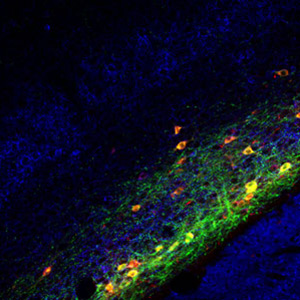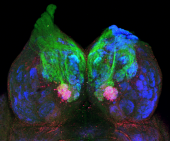We aim to elucidate the neural circuit mechanisms underlying olfaction and consciousness.


Yoshihiro Yoshihara, Ph.D.
Team Director, Systems Molecular Ethology
yoshihiro.yoshihara@riken.jp
- Research Overview
- Selected Publications
- News & Media
- Lab Members
- Curriculum Vitae
- Postdoctoral Researcher or Research Scientist Position (W22322)
- Research Associate Position Position (W23264)
Research Overview
Olfaction
Animals can perceive a huge number of odorants and pheromones in the external world, which evoke fundamental olfactory behaviors such as food searching, danger avoidance, mate choice, and memory recall. By using zebrafish as a model organism, we aim to clarify the molecular, cellular and circuit mechanisms underlying functional architecture of the olfactory system responsible for various odor-evoked behaviors and physiological changes.
Claustrum
The claustrum is a thin, sheet-like neuronal structure hidden beneath the inner surface of the mammalian cerebral cortex, whose function is enigmatic. Our group revealed that the claustrum orchestrates cortical slow-wave activity by inducing synchronous and global silencing of cortical neurons. We further advance this study to decipher the role of the claustrum in higher brain functions such as memory consolidation, attentional load allocation, and consciousness.
Main Research Fields
Biological Sciences
Related Research Fields
Biology
Keywords
- olfaction
- neural circuit
- behavior
- consciousness
- claustrum
Selected Publications
- Masuda M, Ihara S, Mori N, Koide T, Miyasaka N, Wakisaka N, Yoshikawa K, Watanabe H, Touhara K, Yoshihara Y:
“Identification of olfactory alarm substances in zebrafish”
Current Biology 34, 1377-1389 (2024).
10.1016/j.cub.2024.02.003 - Narikiyo K, Mizuguchi R, Ajima A, Shiozaki M, Hamanaka H, Johansen JP, Mori K, Yoshihara Y.
"The claustrum coordinates cortical slow-wave activity"
Nature Neuroscience 23, 741-753 (2020).
10.1038/s41593-020-0625-7 - Koide T, Yabuki Y, Yoshihara Y:
"Terminal nerve GnRH3 neurons mediate slow avoidance of carbon dioxide in larval zebrafish"
Cell Reports 22, 1115-1123 (2018).
10.1016/j.celrep.2018.01.019 - Wakisaka N, Miyasaka N, Koide T, Masuda M, Hiraki-Kajiyama T, Yoshihara Y:
"An adenosine receptor for olfaction in fish"
Current Biology 27, 1437-1447 (2017).
10.1016/j.cub.2017.04.014 - Yabuki Y, Koide T, Miyasaka N, Wakisaka N, Masuda M, Ohkura M, Nakai J, Tsuge K, Tsuchiya S, Sugimoto Y, Yoshihara Y:
"Olfactory receptor for prostaglandin F2α mediates male fish courtship behavior"
Nature Neuroscience 19, 897-904 (2016).
10.1038/nn.4314 - Miyasaka N, Arganda-Carreras I, Wakisaka N, Masuda M, Sümbül U, Seung HS, Yoshihara Y:
"Olfactory projectome in the zebrafish forebrain revealed by genetic single-neuron labeling"
Nature Communications, DOI: 10.1038/ncomms4639 (2014).
10.1038/ncomms4639 - Kaneko-Goto T, Sato Y, Katada S, Kinameri E, Yoshihara S, Nishiyori A, Kimura M, Fujita H, Touhara K, Reed RR, Yoshihara Y:
"Goofy coordinates the acuity of olfactory signaling"
Journal of Neuroscience, 33, 12987-12996 (2013).
10.1523/JNEUROSCI.4948-12.2013 - Mizuguchi R, Naritsuka H, Mori K, Mao CA, Klein WH, Yoshihara Y:
"Tbr2 deficiency in mitral and tufted cells disrupt excitatory-inhibitory balance of neural circuitry in the mouse olfactory bulb"
Journal of Neuroscience, 32, 8831-8844 (2012).
10.1523/JNEUROSCI.5746-11.2012 - Koide T, Miyasaka N, Morimoto K, Asakawa A, Urasaki A, Kawakami K, Yoshihara Y:
"Olfactory neural circuitry for attraction to amino acids revealed by transposon-mediated gene trap approach in zebrafish"
Proceedings of National Academy of Science USA, 106, 9884-9889 (2009).
10.1073/pnas.0900470106 - Kaneko-Goto T, Yoshihara S, Miyazaki H, Yoshihara Y:
"BIG-2 mediates olfactory axon convergence to target glomeruli"
Neuron, 57, 834-846 (2008).
10.1016/j.neuron.2008.01.023
News & Media
-
-

-
Smelling danger in the water: Schreckstoff mystery solved after 86 years!
-
-
-

-
Meet the region of the brain that may control your consciousness
-
-
-

-
A ‘consciousness conductor’ synchronizes and connects mouse brain areas
-
-
-

-
Identifying the olfactory neuronal circuit responsible for appetizing smells; zebra fish are found to have a special fondness for amino acids.
-
-
-

-
Running away from carbon dioxide: the terminal connection
-
-
-

-
This nasal receptor mediates the appetizing smell of fish food
-
-
-

-
Fish love the smell of adenosine — well, anytime
-
-
-

-
Fish courtship pheromone uses the brain's smell pathway
-
-
-

-
Male fish need a sense of smell to get it on
-
-
-

-
The path to olfaction
Elucidating the existence of bilaterally unsymmetrical neuronal networks in olfactory neurons, suggesting a close relationship between olfaction and emotion exemplified by the like/dislike of odors
-
-
-

-
Without BIG-2, odor maps stink
RIKEN researchers identify a protein that guides the formation of brain circuit networks essential for processing olfactory information.
-
-
-

-
Telencephalin, a Molecule Necessary to Keep the Brain Pliable
-
-
-

-
Identification of Robo2 as a Crucial Gene for Neural Circuitry Formation in the Zebrafish Olfactory System
-
-
-

-
The trailblazers' guides in olfactory development
-
-
-

-
Successful selective visualization of multisynaptic neural pathways: A new way to observe the structure and functions of the brain.
-
Lab Members
Principal investigator
- Yoshihiro Yoshihara
- Team Director
Core members
- Takahiro Hino
- Postdoctoral Researcher
- Ling Fei Tee
- Postdoctoral Researcher
- Ugurcan Sakizli
- Postdoctoral Researcher
- Misaki Takaoka
- Junior Research Associate
- Aki Arai
- Technical Staff I
- Miho Urabe
- Technical Staff I
- Emi Kageyama
- Technical Staff I
- Nao Kimura
- RIKEN Student Researcher M



